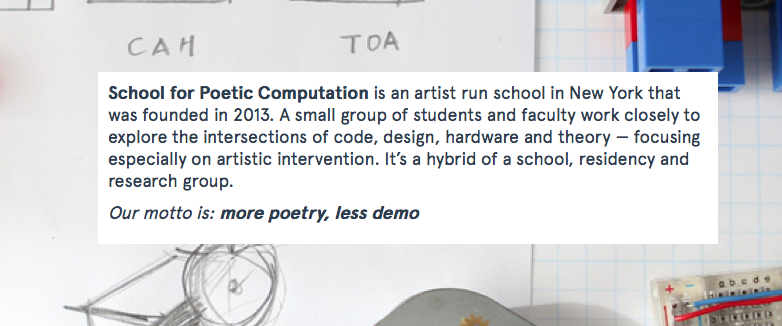School for Poetic Computation - Day 1
October 1st is day 1 of SFPC. I’ll be spending the next 10 weeks in the Lower East Side of Manhattan to learn and create with 15 other amazing students and a number of teachers.

Activities on day 1 included some introductions, writing down as many questions as possible about the next 10 weeks, examples of work that Zach considers poetic computation, and a game of “human fax machine.”
The Poetry in Poetic Computation
The school’s name was chosen quite thoughtfully. One reason is because poetry “celebrates small explorations.” For example, Laura Belém’s installation “Enamorados” at the 2005 Venice Biennial consisted of two boats with lights facing each other and sending signals via the lights such that it looked like they were in conversation. It was subtle, simple, and beautiful. The other works mentioned are here.

Themes to play with
While going through the works, Zach mentioned a few themes that artists play with in different works. For example, some works play with “transmission: encoding and decoding” while others explore “what-if questions.” “Re-ordering” was another one. It’ll be interesting to add to this list as the semester goes on, and use it for inspiration.
“Human Fax Machine”
My favorite part of the day was the “Human Fax Machine”. Our group of 4 had to figure out a code we could use to describe how to draw a line drawing. Then 2 of us started with a drawing and could make sounds, but not speak or gesture, to communicate to the other team. Our goal was to give the others enough information to draw the same drawing. The other two would then have to interpret the sounds and then draw a picture, hopefully the same image that the first group started with.
I suggested including a sound to confirm that we “got it, go on” and a sound for “didn’t get that, please repeat.” These ended up being quite helpful. One of my teammates added an awesome “drumroll” sound to signal that the drawing was done and to connect the last point to the starting point. This was extra useful because it ensured that we wouldn’t end up with the lines not quite connecting at the end. I found that keeping a tally of the information being sent helped us separate receiving the information from transcribing it into the drawing.
We started with only straight line drawings, and in the second round added curves.
Here are some pictures of our drawing pad and tally sheets.



All in all, it was amazing to realize how much we could convey with only 7 distinct sounds. I liked that the sounds we chose were sometimes representational, like the drumroll or the sound for “curvy.” It was also super fun to work together to explore this problem.
That’s the end of day 1.

And it’s just beginning…